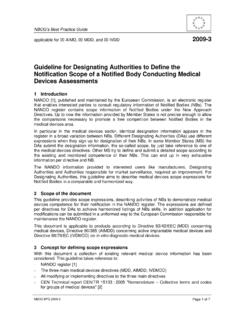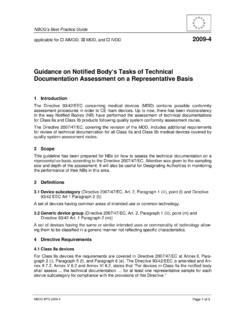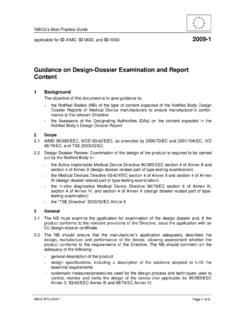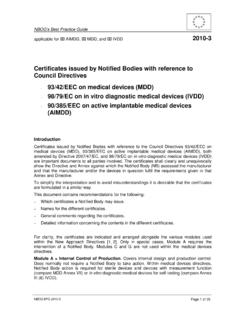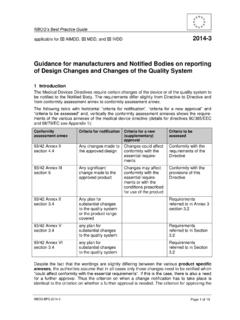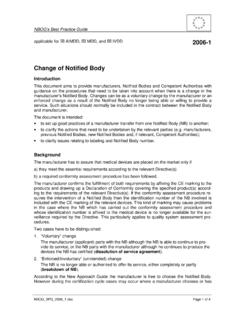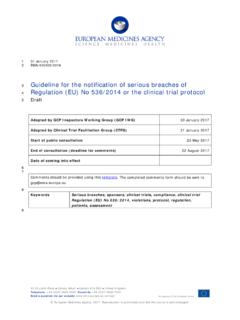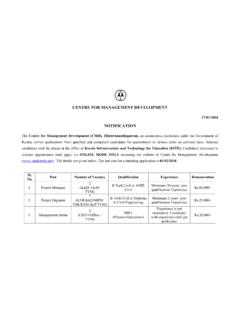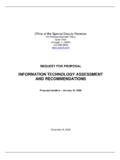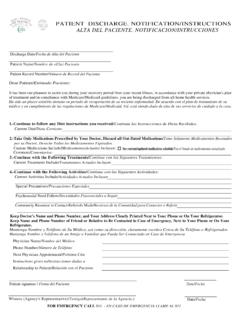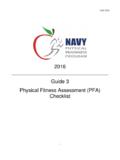Transcription of Designation and notification of conformity …
1 NBOG s Best Practice Guide applicable for MDR, and IVDR 2017-1 NBOG BPG 2017-1 rev. 1 Page 1 of 16 Designation and notification of conformity assessment bodies 1 1 Introduction and scope This document aims to provide guidance to the authorities responsible for notified bodies (hereafter, the designating authorities) and joint assessment teams (JATs) when conducting Designation assessments of conformity assessments bodies (CABs) that apply for Designation as a notified body in the field of medical devices and/or in vitro diagnostic medical devices. Furthermore, this guide is intended to bring consistency and to align the working practices of the different designating authorities in the Member States 2, regarding the assessment , Designation and notification 3 of CABs.
2 These processes are established by Articles 38 to 42 of Regulation (EU) No 2017/745 4 (hereafter, the medical devices Regulation MDR) and Articles 34 to 38 of Regulation (EU) No 2017/746 5 (hereafter, the in vitro diagnostic medical devices Regulation IVDR). In terms of scope, this guide focuses on the first Designation of CABs under the MDR and/or the IVDR. Once sufficient experience from this process has been gathered, it may be updated accordingly. 2 Pre- assessment and off-site activities CAB s application When applying for Designation , CABs need to use the application form(s) required by the designating authorities and submit the corresponding supporting documentation: form NBOG F 2017-1 for Designation under the MDR, and/or form NBOG F 2017-2 for Designation under the IVDR.
3 The content of the application will include a specification of the conformity assessment activities and types of devices to be covered by the Designation , using the codes set out in Implementing Regulation (EU) 2017/XX 6 and specified in the corresponding NBOG form (NBOG F 2017-3 or NBOG F 2017-4). 1 The applicability of Best Practice Guides (BPGs) covering requirements set out in the new medical devices Regulations are contingent upon endorsement by the Medical Device Coordination Group (MDCG). In particular where its involvement is referred to in such BPGs, it must be emphasised that the MDCG should ultimately agree on the relevant steps and deadlines. 2 References made to 'Member States' in this guide, should be understood as referring to Member States, EEA and EFTA countries and other countries where a relevant agreement covering mutual recognition of Designation of notified bodies exists.
4 3 At present, this document does not elaborate on the different steps covering notification of CABs. Once this part is developed, the BPG will be updated accordingly. 4 Regulation (EU) 2017/745 on medical devices, amending Directive 2001/83/EC, Regulation (EC) No 178/2002 and Regulation (EC) No 1223/2009 and repealing Council Directives 90/385/EEC and 93/42/EEC (OJ L 117, , p. 1). 5 Regulation (EU) 2017/746 on in vitro diagnostic medical devices and repealing Directive 98/79/EC and Commission Decision 2010/227/EU (OJ L 117, , p. 176). 6 Commission Implementing Regulation (EU) 2017/XX of 24 November 2017 (expected) on the list of codes and corresponding types of devices for the purpose of specifying the scope of the Designation as notified bodies in NBOG s Best Practice Guide 2017-1 NBOG BPG 2017-1 rev.
5 1 Page 2 of 16 CABs applying for Designation should be aware of the time needed for the assessment of the application, execution of the on-site assessment and subsequent verification activities, Designation and notification . On the basis of the experience gathered during the current joint assessment process, it is expected that CABs designated under the medical devices Directives 7 should apply for Designation at least 18 months prior to the repeal of these Directives, as applicable 8, in order to ensure continuation of their activities under the new legal framework. The flowchart in the annex to this guide illustrates the process and the estimated length of time for each of its steps. Designating authority's check of CAB s application for completeness An initial check is to be carried out by the designating authority to verify the completeness of the CAB's application.
6 The designating authority should indicate in the same application form(s) used by the CAB (see section ) if all documents have been submitted as required (by ticking the relevant boxes). If one or more documents have not been submitted but the application is considered to be complete by the designating authority, it should provide a brief explanation as to why. For this purpose, the designating authority should fill in the box provided in the last page of the relevant form(s). The completeness check will be carried out within 30 days after receipt of the application 9. In the event that information is missing, the designating authority will request this information to the CAB within these 30 days. It is recommended that designating authorities set a deadline for the submission of the missing information.
7 According to its own procedures, if after a number of rounds of correspondence with the CAB the requested information is not forthcoming or it is still incomplete, the designating authority may decide to reject the application and inform the CAB of the need to re-apply for Designation . Transmission of the application to the Commission Once the completeness check has been finalised and the application has been considered complete, it will be sent by the designating authority to the European Commission's Directorate-General for Health and Food Safety, Directorate F (hereafter, SANTE/F) by email (sent to the functional mailbox 10). In case the application is rejected, the designating authority should also inform SANTE/F. All of the documents contained in the application need to be sent to SANTE/F in electronic format.
8 This transmission will normally be carried out by email or via a file-transfer platform. If the CAB has used an encryption method to submit the documents to the designating authority ( an encrypted CD, DVD or memory stick), the CAB could request that the designating authority uses the same form of transmission for security the field of medical devices under Regulation (EU) 2017/745 of the European Parliament and of the Council and in vitro diagnostic medical devices under Regulation (EU) 2017/746 of the European Parliament and of the Council 7 Directive 90/385/EEC on active implantable medical devices, Directive 93/42/EEC on medical devices, and Directive 98/79/EC on in vitro diagnostic medical devices.
9 8 CABs should apply for Designation under the MDR no later than 26 November 2018 and under the IVDR no later than 26 November 2020. 9 Articles 39 (1) of the MDR and 35 (1) of the IVDR. 10 All the email exchanges with SANTE/F referred to in this guide are to be made to and from the functional mailbox NBOG s Best Practice Guide 2017-1 NBOG BPG 2017-1 rev. 1 Page 3 of 16 reasons. In these cases, the designating authority will physically send the data via registered post to SANTE/F 11. The language in which the application is made available will usually be that of the Member State. Nevertheless, it is usually the case that CABs with international clients or international personnel will already have many procedures and related documents in English.
10 Therefore, in order to facilitate the assessment of the application by the JAT, the CAB should also include in the application copies of any documents that are already available in this language, in particular the quality manual, procedures related to qualification of personnel and procedures related to the process of conformity assessments. If these documents are not available in English, the CAB may provide copies of them translated into English in order to facilitate the organisation of the joint assessment . Once the application is received, SANTE/F will acknowledge its receipt via email to the designating authority, informing the European Commission's Directorate-General Internal Market, Industry, Entrepreneurship and SMEs, Directorate D (hereafter referred to as GROW/D).
